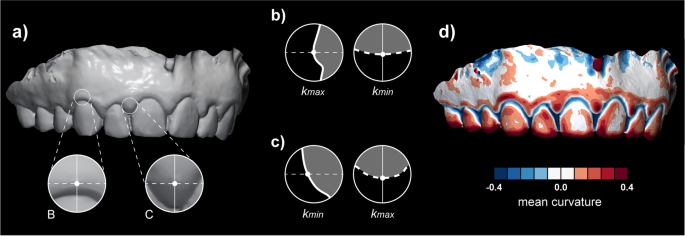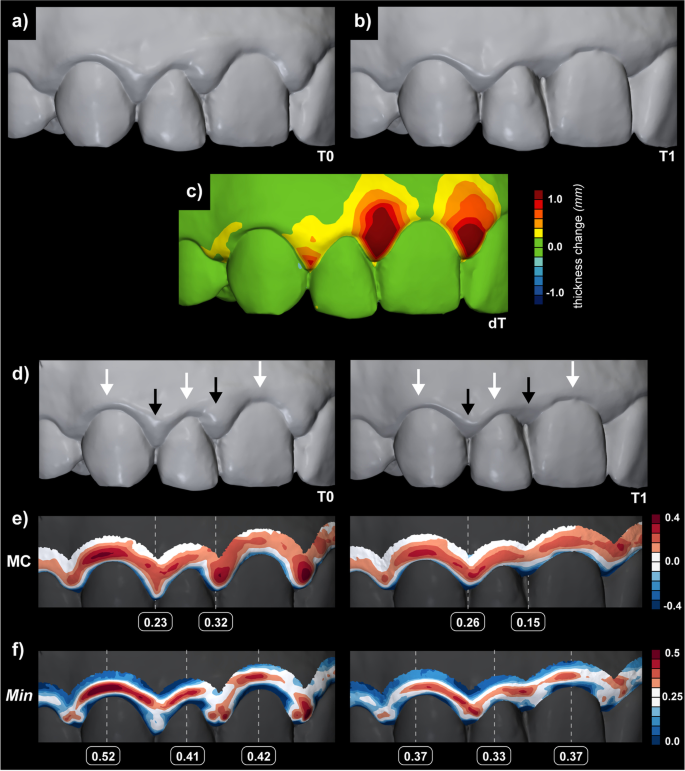Correction: BMC Oral Health 22, 283 (2022)
https://doi.org/10.1186/s12903-022-02322-y
Following the original article's publication [1], the authors identified a terminology issue regarding the principal curvatures, i.e., maximum (kmax) and minimum (kmin), and maximum (Max) and minimum (Min) curvature measures computed and used in the present study. The algorithm used in the study (i.e., Scale Dependent Quadric Fitting) as implemented in PyMeshLab interfacing to MeshLab (version 2021.10) uses the terms »Max Curvature« (Max) for kmin and »Min Curvature« (Min) for kmax and may therefore confuse the reader.
Following corrections were made for clarification of above issue:
-
Figure 1: kmin and kmax were interchanged in b) and c). Revised figure:

-
Methods – Surface curvature estimation (pg. 3): Following sentence was revised: »All curvature measures mentioned above, i.e., MC, GC, SI, CU, and minimum (Min) and maximum curvature (Max) as implemented in the software were computed at three different diameters, i.e., 0.5, 1, and 2 mm (Fig. 2).«
-
Results - Validation of the proposed method (pg. 4): Following sentence was revised (kmin interchanged to Min): »For central ROI, Min measure computed at 2 mm diameter seems optimal parameter to quantify shape with mean (and standard deviation) of 0.33 (0.07) for a study sample.«
-
Results - Demonstration of the proposed method (pg. 5): Following sentence was revised (kmin interchanged to Min): » Furthermore, visual observation of the cross-sections displayed in Fig. 1 and colour-coded models with all curvature measures computed at 2 mm diameter (Additional file 1: Fig. 1) confirmed that Min and MC measures seem optimal parameters to quantify shape at central and interdental ROI, respectively.«
-
Discussion (pg. 5): Following sentence was revised (kmin interchanged to Min): »Gingival tissues’ shape seems to be optimally evaluated by the Min for central and MC for interdental region, both computed at 2 mm diameter.«
-
Figure 6: kmin was changed into Min in f)

-
Discussion (pg. 8): Following sentence was revised (kmax interchanged to Max): »Those relations are typically displayed as a mesial-distal convexity of central gingival as observed with a mesial-distal cross-section of a maxillary canine (Fig. 1b) and colour-coded curvature maps using Max (Additional file 1: Fig. 1).
-
Discussion (pg. 9): Following sentence was revised (kmin interchanged to Min): »With gingival inflammation, swelling occurs, additionally and reliably displayed with Min (Fig. 5a).«
-
Abbreviations (pg. 9): The difference was outlined with revising and adding following abbreviations: »kmax: Maximum principal curvature; kmin: Minimum principal curvature; Max: maximum curvature measure; Min: minimum curvature measure«
Reference
Kuralt M, et al. Gingival shape analysis using surface curvature estimation of the intraoral scans. BMC Oral Health. 2022;22:283. https://doi.org/10.1186/s12903-022-02322-y.
Author information
Authors and Affiliations
Corresponding author
Rights and permissions
Open Access This article is licensed under a Creative Commons Attribution 4.0 International License, which permits use, sharing, adaptation, distribution and reproduction in any medium or format, as long as you give appropriate credit to the original author(s) and the source, provide a link to the Creative Commons licence, and indicate if changes were made. The images or other third party material in this article are included in the article's Creative Commons licence, unless indicated otherwise in a credit line to the material. If material is not included in the article's Creative Commons licence and your intended use is not permitted by statutory regulation or exceeds the permitted use, you will need to obtain permission directly from the copyright holder. To view a copy of this licence, visit http://creativecommons.org/licenses/by/4.0/. The Creative Commons Public Domain Dedication waiver (http://creativecommons.org/publicdomain/zero/1.0/) applies to the data made available in this article, unless otherwise stated in a credit line to the data.
About this article
Cite this article
Kuralt, M., Cmok Kučič, A., Gašperšič, R. et al. Correction: Gingival shape analysis using surface curvature estimation of the intraoral scans. BMC Oral Health 22, 577 (2022). https://doi.org/10.1186/s12903-022-02554-y
Accepted:
Published:
DOI: https://doi.org/10.1186/s12903-022-02554-y



